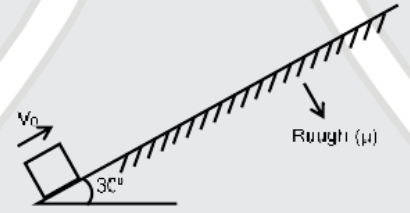A particle is projected up a rough incline with velocity . If , the speed with which it returns back to the starting point is . Then is
The correct Answer is:C
To solve the problem, we need to analyze the motion of a particle projected up a rough incline and determine the ratio of its return speed to its initial speed. Here’s a step-by-step breakdown of the solution:
Step 1: Understand the Forces Acting on the Particle
When the particle is projected up the incline:
- The gravitational force acting on it can be resolved into two components:
- Parallel to the incline: mgsinθ
- Perpendicular to the incline: mgcosθ
- The frictional force acting against the motion is given by Ff=μN=μmgcosθ, where μ is the coefficient of friction.
Step 2: Calculate the Retardation While Going Up
The total retardation A1 while the particle is moving up can be expressed as:
A1=gsinθ+μgcosθ
Substituting μ=12:
A1=gsinθ+12gcosθ
Step 3: Use the Equation of Motion for Ascent
Using the equation of motion:
v2=u2−2A1s
Where:
- v=0 (final velocity at the highest point)
- u=v0 (initial velocity)
- s is the distance traveled up the incline.
Thus, we have:
0=v20−2A1s⟹v20=2A1s
Step 4: Calculate the Retardation While Coming Down
When the particle comes down, the forces acting on it are:
- Gravitational force down the incline: mgsinθ
- Frictional force acting up the incline: Ff=μmgcosθ
The net acceleration A2 while coming down is:
A2=gsinθ−μgcosθ
Step 5: Use the Equation of Motion for Descent
Using the equation of motion again:
v2=u2+2A2s
Where:
- u=0 (initial velocity at the top)
- v is the final velocity when it returns to the starting point.
Thus, we have:
v2=2A2s
Step 6: Relate the Two Equations
From the ascent:
v20=2A1s
From the descent:
v2=2A2s
Now, we can find the ratio v2v20:
v2v20=A2A1
Step 7: Substitute the Values of A1 and A2
Substituting the expressions for A1 and A2:
A1=gsinθ+12gcosθ
A2=gsinθ−12gcosθ
Step 8: Calculate the Ratio
Now substituting these into the ratio:
A2A1=gsinθ−12gcosθgsinθ+12gcosθ
This simplifies to:
A2A1=sinθ−12cosθsinθ+12cosθ
Step 9: Substitute θ=37∘ and Calculate
Using sin37∘=35 and cos37∘=45:
A2A1=35−12⋅4535+12⋅45=35−2535+25=151=15
Step 10: Find the Final Ratio
Thus, we have:
v2v20=15⟹vv0=1√5
Final Answer
The ratio vv0 is 1√5.
---
When the particle is projected up the incline:
- The gravitational force acting on it can be resolved into two components:
- Parallel to the incline: mgsinθ
- Perpendicular to the incline: mgcosθ
- The frictional force acting against the motion is given by Ff=μN=μmgcosθ, where μ is the coefficient of friction.
The total retardation A1 while the particle is moving up can be expressed as:
A1=gsinθ+μgcosθ
Substituting μ=12:
A1=gsinθ+12gcosθ
Using the equation of motion:
v2=u2−2A1s
Where:
- v=0 (final velocity at the highest point)
- u=v0 (initial velocity)
- s is the distance traveled up the incline.
0=v20−2A1s⟹v20=2A1s
When the particle comes down, the forces acting on it are:
- Gravitational force down the incline: mgsinθ
- Frictional force acting up the incline: Ff=μmgcosθ
A2=gsinθ−μgcosθ
Using the equation of motion again:
v2=u2+2A2s
Where:
- u=0 (initial velocity at the top)
- v is the final velocity when it returns to the starting point.
v2=2A2s
From the ascent:
v20=2A1s
From the descent:
v2=2A2s
v2v20=A2A1
Substituting the expressions for A1 and A2:
A1=gsinθ+12gcosθ
A2=gsinθ−12gcosθ
Now substituting these into the ratio:
A2A1=gsinθ−12gcosθgsinθ+12gcosθ
This simplifies to:
A2A1=sinθ−12cosθsinθ+12cosθ
Using sin37∘=35 and cos37∘=45:
A2A1=35−12⋅4535+12⋅45=35−2535+25=151=15
Thus, we have:
v2v20=15⟹vv0=1√5
The ratio vv0 is 1√5.
Topper's Solved these Questions
Similar Questions
A paricle is projected up from the bottom of an inlined plane of inclination α with velocity v0 If it returns to the points of projection after an elastic impact with the plane, find the total time of motion of the particle.
View SolutionA particle is projected vertically upwards with a velocity v. It returns to the ground in time T. Which of the following graphs correctly represents the motion.
View Solution
Knowledge Check
- Question 1 - Select One
A particle is projected up a 45∘ rough incline with a velocity v. The coeffciient of friciton is 0.5. The speed with which it returns back to the starting point is v'. Then v' /v is :
A√2/√3B1/√3C1/2D1/√2 - Question 2 - Select One
A particle is projected directly along a rough plane of inclination θ with velocity u. If after coming to the rest the particle returns to the starting point with velocity v, the coefficient of friction between the partice and the plane is
Au2v2tanθBu2−v2u2+v2tanθCv2u2tanθDu2+v2u2−v2tanθ - Question 3 - Select One
A particle of mass m is projected upword with velocity v=ve2 (ve) escape of the particle is
A−GMm2RB−GMm4RC−3GMm4RD−2GMm3R
A body is projected up along the rough inclined plane from the bottom with some velocity. It travels up the incline and then returns back. If the time of ascent is ta and time of descent is td then
View SolutionTwo particles A and B projected simultaneously from a point situated on a horizontal place. The particle A is projected vertically up with a velcity vA while the particle B is projected up at an angle 30∘ with horizontal with velocity vB. After 5s the particles were observed moving mutually perpendicular to each other. The velocity of projection of the particle vAandvB respectively are:
View SolutionA particle of mass m is projected upwards with velocity v=ve2, where ve is the escape velocity then at the maximum height the potential energy of the particle is : (R is radius of earth and M is mass of earth)
View SolutionA block starts going up a rough inclined plane with velocity V0 as shown in figure.After some time reaches to starting point again, with a velocity V02.Find coefficient of friction μ .Given g=10msec2.
 View Solution
View SolutionA sphere is projected up an inclined plane with a velocity v0 and zero angular velocity as shown. The coefficient of friction between the sphere and the plane is μ=tanθ.. Find the total time of rise of the sphere.
 View Solution
View Solution

